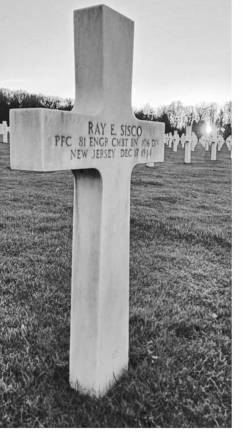
Second of two parts
A face from the 1940s is that of McAfee’s Private First Class Ray Sisco, U.S. Army.
He was declared killed in action, missing in action as a result of the Battle of the Bulge in the winter of 1944-45 during World War II.
This story is told by Ken Carlsen, who investigated Sisco’s last actions when Carlsen was posted at U.S. Consul General Frankfurt.
This is from his report to the superintendent for the Ardennes American Cemetery in France.
The drive to Bleialf
On 17 December 1944, Company “B” 81st Combat Engineers and 423rd Infantry (ID) personnel traveled from Schonberg to Bleialf in a jeep. While on the Schonberg-Bleialf Road, it is believed that PFC Sisco’s jeep was hit by a mortar fired from a German position. PFC Sisco with S/Sgt Maxwell Swain, 423rd ID; Stephen Turner; Aloisius Bauer; possibly Clealon C Jones; and U.S. Army’s unknown X-6041 (described as “blown to bits” (BTB)) were instantly killed in action (KIA). All six were hastily buried in unmarked graves alongside the Schonberg-Bleialf Road.
Subsequent reports reveal that X-6041’s skull top and foot bone fragments were found around May 1947 by a de-mining team working in the Schneifel Ridge area and given to the Hontheim (French Occupied Zone) Burgermeister.
Hontheim Burgermeister kept X-6041’s skull and bone fragments at a church until the French police ordered him to build a casket and bury the remains. I believe when X-6041 was BTB; his skull and bone fragments were separated from his body and remained on the surface whereas the rest of his remains were buried along with five of PFC Sisco’s comrades. X-6041 is still unknown and buried in a grave marked “Unknown But to God” at the ABMC Ardennes.
German poet’s work
At the end of World War II, PFC Sisco should have been declared missing in action and presumed dead.
Michael Blum (1876-1955), German poet and co-founder of the Bleialf War Cemetery at age 69, made it his mission to take special care of the fallen soldiers as he described as “his boys” from the American, British Commonwealth and German armies.
Blum made sure that the corpses of fallen soldiers scattered across the Schneifel Ridge area, where PFC Sisco died, were recovered and given a dignified burial without any assistance from the Occupying Forces (French & American) or the German government.
According to the 106th Infantry Division Association newsletter Volume 53 dated October 1996, a family of a German prisoner of war in England related to Blum had notified the American government that Blum found the remains of PFC Sisco and the other five in a shallow grave alongside a road drainage ditch.
Blum relocated the six Americans from the roadside drainage ditch grave to the Bleialf War Cemetery sometime in late 1946 or early 1947.
‘Do not forget us, for we died for you’
Due to Blum’s work, many American families of missing in action or killed in action soldiers assisted him with food and clothing during the years after the war.
The people of the Village of Bleialf have rededicated the military portion of their cemetery to Blum’s memory. Today at the Bleialf War Cemetery, you can still see the empty graves, which I believe were the American graves dug by Blum.
Eventually, all Bleialf War Cemetery’s American casualties were repatriated to the United States or relocated to other cemeteries outside of Germany.
Bleialf War Cemetery notes that Blum buried more than 244 soldiers from World War II. When Blum could, he would notify the relatives directly and provide free accommodation and food to cemetery visitors.
With assistance from the local administration, Blum prevented Bleialf War Cemetery soldiers’ graves from reburial. In Germany, when there are no bones from the previous decedent, it is common to reuse a grave for another decedent’s “reburial.”
Sisco’s final journey
Sometime between 1947 and August 1948, the remains of PFC Sisco and his comrades were relocated from Bleialf War Cemetery to U.S. Military Cemetery (USMC) Ardennes; now known as American Battlefield Monuments Commission (ABMC) Ardennes American Cemetery.
USMC Ardennes was the U.S. Army’s Mortuary Affairs location for the processing and identification of all Europe’s unknowns.
According to ABMC Ardennes American Cemetery’s superintendent, If a person was buried at USMC Ardennes, they required subsequent identification processing before being repatriated to the United States or being interned overseas.
On 14 October 1949, an initial identification was made of PFC Sisco’s remains along with S/SGT Jones. PFC Sisco was buried at Section AA, Row 6, Grave 131, which no longer exists.
Due to similar teeth structures between Sisco and Jones, further reprocessing of PFC Sisco’s remains was ordered on 30 June 1950.
Between 8 August 1950 and 15 April 1951, Mortuary Affairs finally confirmed the identity of PFC Sisco, and he was finally placed in his final resting spot at ABMC Ardennes American Cemetery Section D, Row 7, Grave 32.
Carlsen may be contacted at Carlsenkjccomm@yahoo.com
Bill Truran, Sussex County’s historian, may be contacted at billt1425@gmail.com